Looking at the photo below, it would be easy to think you were in Canada or somewhere in the mountains in the United States, walking alongside a clear, untroubled lake. For a moment you might wonder at the colour or the patterning on the bark of the fallen tree, but any differences from normal would be easy to overlook.
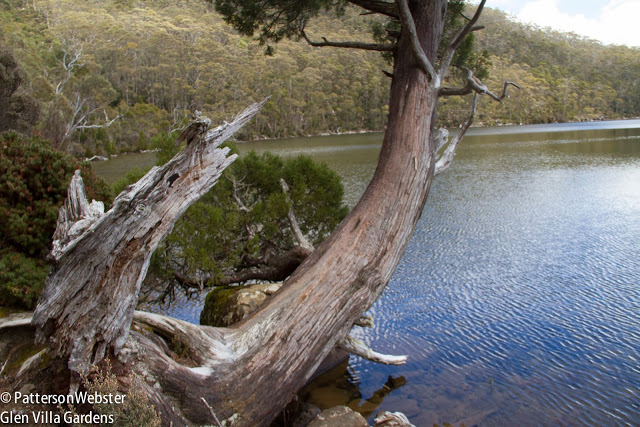 |
| A typical mountain lake: but where is it? |
If you walked a short distance beyond the lake, you’d come across vegetation similar to many high altitude areas, where winds sweep the ground clear and only low growing alpine plants can survive.
 |
| The tundra looks as familiar as the mountain lake. Is it Newfoundland? Maybe a remote area of Scotland? |
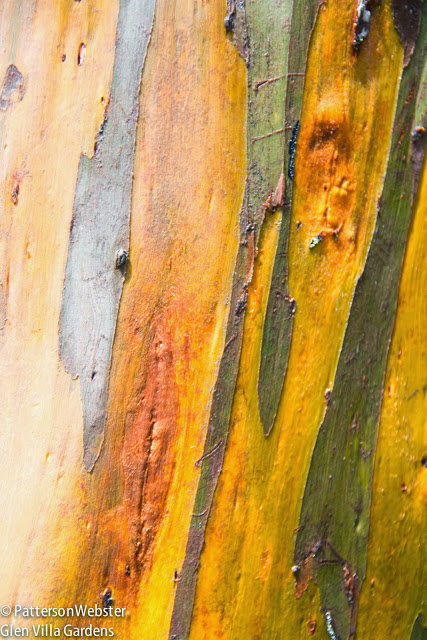 |
| Eucalyptus coccifera, or alpine gum |
I haven’t manipulated the colour of the photo — it really is the intense yellow shading to orange that you see. And those bits of bark peeling off the trunk really are pale green and tan.
I took the photos earlier this week in Tasmania, home country for some of the most interesting vegetation in the world. Unlike most of Australia, Tasmania’s climate is mild for a good part of the year. The island isn’t large — about 300 kilometres (about 190 miles) from top to bottom and from side to side. Yet it contains a diversity of topography, vegetation and climatic conditions that make it seem much larger.
Not far from Hobart, the state’s capital on the south end of the island, is a national park established over 100 years ago. Mount Forest National Park combines rainforest and alpine environments in a setting so naturally spectacular that it is hard to believe the park hasn’t been designed and planted to order.
The park has lots of tricks up its green sleeves, plants that look familiar but differ in significant ways, or plants with names like dogwood that aren’t dogwood at all. Take this unfurling fern frond. To my eyes, it looks very much like the fiddlehead ferns that open up in the spring in my garden in Quebec.
 |
| Is this an ostrich fern frond? |
But the plant doesn’t look the same. Where the ferns in my woods grow to 24 inches or so, this fern gets BIG — easily reaching six feet or more. Thus its common name: the man fern.
.
 |
| Dicksonia antarctica is commonly called man fern because of its height. |
And then there are the trees. Mt Forest is home to the largest flowering trees in the world. Swamp gums (eucalyptus regnans) here grow to an amazing 85 meters (approx. 250 feet) or more. Looking up, it is hard to get a sense of size.
 |
| This tree may be only a puny 70 meters or so. |
A person standing by the foot of another tree gives some sense of the girth of these monsters. This tree, named the Bigger Tree, is a whooping 87 meters (about 290 ft.) tall.
 |
| A man just under 6 ft tall looks tiny beside the base of this tree. |
The same person standing by a tree alongside the logging road gives an even clearer sense of the size of these trees.
 |
| I wish we’d measured the length of this tree. |
An unexpected difference in size can transform a familiar plant into something other-worldly. Consider the plant we call heath of the botanical family Ericaceae. These flowering shrubs, usually small, are often used as ground covers in northern hemisphere gardens. And some heaths at Mount Forest, like the one below, would be happy in a garden setting.
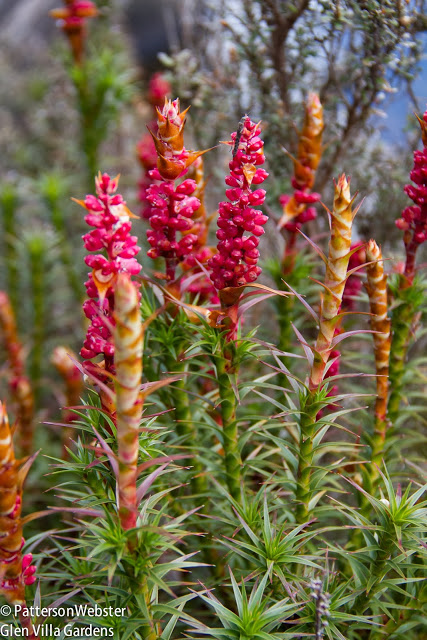 |
| I don’t remember the name of this heath, but I do remember that it was VERY prickly. |
But others look nothing like the heaths I know. Pandani (Richea pandanifolia) is the world;s tallest member of the heath family. Walking among a grove of them is a strangely spiritual experience, particularly when no one else is nearby. (Except our guide, the excellent Graham McLean of Tasmanian Wilderness Experience, and his partner Carolyn. Both are extremely knowledgeable, and I thank them for a marvellous day.)
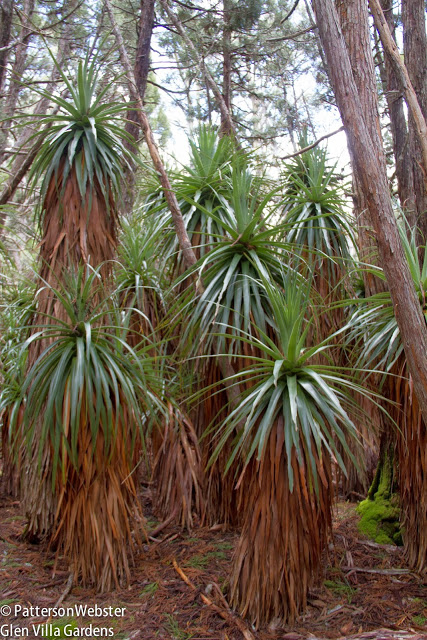 |
| The brown fronds provide insulation in winter. |
The earliest Europeans arriving here, primarily as convicts in the early 1800s, gave the plants familiar names that recalled England and home. The native laurel (Anopterus glandulosus) is an evergreen with dark green shiny leaves, but botanically it is quite different from laurels in the northern hemisphere.
 |
| The blossom of Australian laurel is similar to the North American plant. |
The same is true for beech trees, and the myrtle beech. Although the name is the same, the plants in the southern hemisphere are, botanically, completely different from those in the northern hemisphere.
In spring the new growth on an Australian myrtle is a stunning red, particularly bright against a clear blue sky. The red leaves contain a toxin that discourages the local browsing animals — a trait I wish hostas would develop.
 |
| No, it isn’t autumn here, but spring. In the Antipodes, everything is upside down. Or maybe it’s the other way around? |
Myrtle beech isn’t a beech at all, and its botanical name says that: nothofagus cunninghamii: fagus for beech, notho meaning not really, (actually its a prefix meaning false, bastard or spurious) and cunningham for ??? (Perhaps for a botanist or early explorer; it’s a question I forgot to ask.)
Trees around the mountain lake we visited were decorated with what I would have called Spanish moss. But these bits of fluff, commonly called Old Man’s Beard, come from a totally different species.
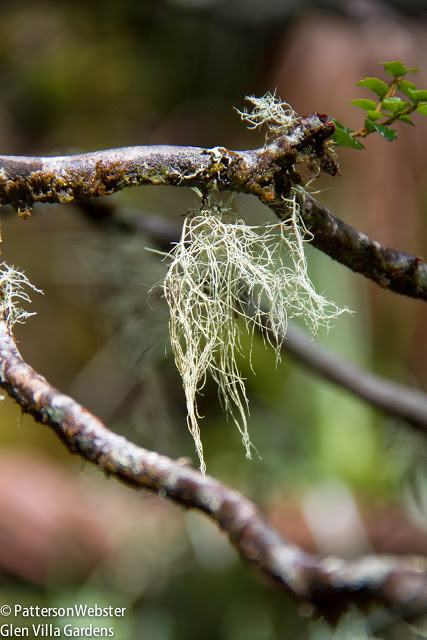 |
| Usnea is a type of lichen that grows widely around the world. It isn’t Spanish moss, which is neither a lichen nor a moss. |
This is one of Tasmania’s many surprises: the number of plants and places that either look familiar or share similar names. Old man’s beard is a type of lichen called usnea, and Spanish moss is usneoides, which means resembling Usnea. So the look-alikes and name-alikes work in both directions, north to south and south to north.
On our walk we saw and heard many birds but we saw one special animal, a pademelon. Very much like a kangaroos in body structure, the pademelon is a small marsupial. Again, names tell you a lot.
 |
| This small marsupial is a pademelon. I think she is pregnant, but she didn’t want to say. |
Pademelon is a corruption of badimaliyan, from the Dharuk aboriginal language spoken around Port Jackson.






Amazing country. You do a lot of traveling, don’t you?
Yes, we travel a lot — sometimes too much! But Tasmania (and most of Australia) is an amazing place. So much is strange and wonderful to see. Lots to learn about, which I gives me pleasure.
We’re headed to Australia/New Zealand in February. I’ve heard Tasmania is not to be missed, but I didn’t know in time to plan a visit. I know you make rather frequent trips to Australia. If I could do it again, I’d spend several weeks exploring the country.
I’ve been surprised by how much there is to see and do in what I thought was a relatively small island. The diversity is enormous, from beaches to small historic towns to charming cities to rainforest to mountain bleakness. We’re spending 10 days here and it isn’t nearly enough. I’d love to return.
Pat you do get around! I love Australia and its flora and fauna, and marsupials. A big regret is that I can’t grow some of the Australian flora I admire. Enjoy your travels!
I agree. I get plant envy every time we are here.